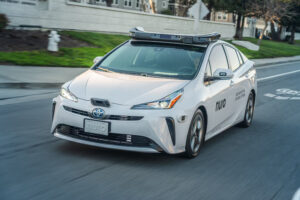Nuro has announced further details about the Nuro Driver’s next-generation sensor architecture, engineered to offer “unmatched safety, performance and scalability”, the company says.
Built for scalability
When most people imagine a self-driving car, they picture a vehicle covered in large, spinning sensors. While these autonomous vehicles certainly work, they’re difficult to manufacture at scale.
The latest iteration of the Nuro Driver’s sensor architecture is designed for scaling, featuring advanced and robust commercially available automotive-grade sensors that are said to ensure high performance and reliability at lower operational costs.
The updated modular design has been engineered to enable swift, seamless integration with diverse vehicle platforms and support various levels of autonomy for different applications, from L2+ ADAS-equipped personal vehicles to fully autonomous L4 robotaxis and goods delivery vehicles.
Unlike the current elevated arched design, the Nuro Driver’s sensor architecture keeps a low profile, providing improved performance in a much smaller footprint. The compact arrangement is said to blend with any style of vehicle, delivering improved aerodynamics for high-speed driving and reducing visual obstacles for other road users.

Sensor architecture
Cameras, lidar and radar sensors are arranged to provide a redundant, 360° field of view for maximum scene detection and safety, enabling the Nuro Driver to see more, better and farther.
The sensor architecture features four kinds of cameras – ultra-long-range, long-range, short-range and traffic light-detection. The cameras provide the Nuro Driver with critical information about colours and lane markings.
The ultra-long-range camera has a 30° horizontal field of view that enables the Nuro Driver to detect extremely small objects at great distances. This is particularly important for highway driving. The updated cameras are 24-bit HDR, mitigate LED flicker and enhance visibility in challenging lighting conditions like dawn and dusk.
The long- and short-range lidar sensors provide the Nuro Driver with precise distance and depth information. Instead of traditional rotary lidar sensors, Nuro has adopted small solid-state lidar with enhanced long-range detection and improved side and rear visibility. This update also means the architecture has fewer moving parts, enhancing reliability and ease of manufacturing.
The long-range, high-resolution imaging radar sensors used by the Nuro Driver help detect the distance and depth of small, distant objects, even in challenging weather. Additional radar sensors offer long-range elevation data with improved velocity and angular resolution, supporting the system’s ability to identify and respond to high-speed vehicles and cross-traffic.
The next-generation sensor architecture also includes a microphone with enhanced audio processing to detect emergency vehicle sirens, along with an upgraded inertial measurement unit (IMU) rated at Automotive Safety Integrity Level D (ASIL-D), the highest safety integrity rating for automotive systems. These two sensors ensure the Nuro Driver shares the road safely and responsibly.
Prepared for the Road Ahead
Nuro says that the sensors featured in the latest-generation sensor architecture have undergone “rigorous validation and testing”, both in the lab and in the field. The company found that all of the sensors displayed significant improvements in challenging weather conditions and long-distance detection of road debris, animals and vulnerable road users like cyclists.


